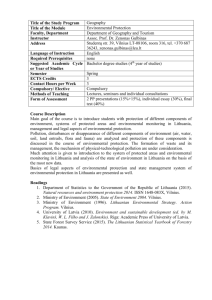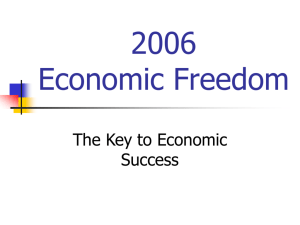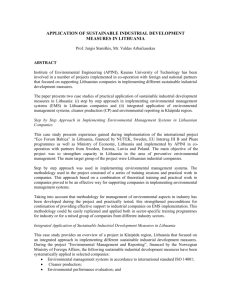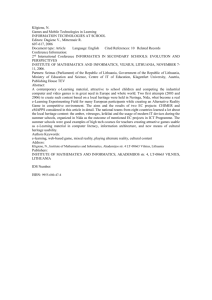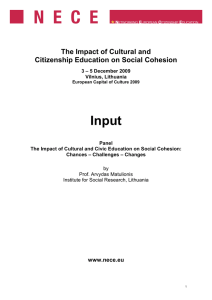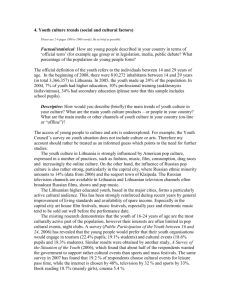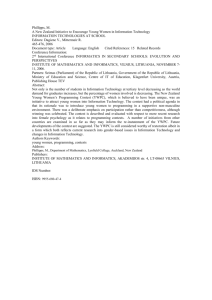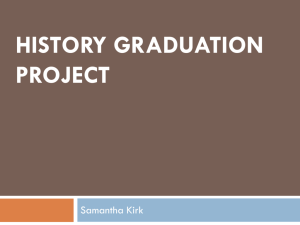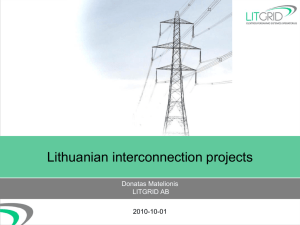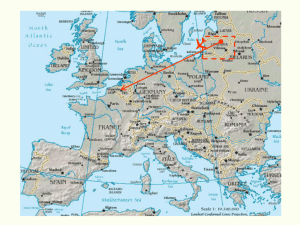File - SUISMUN 2013 Official Website
advertisement
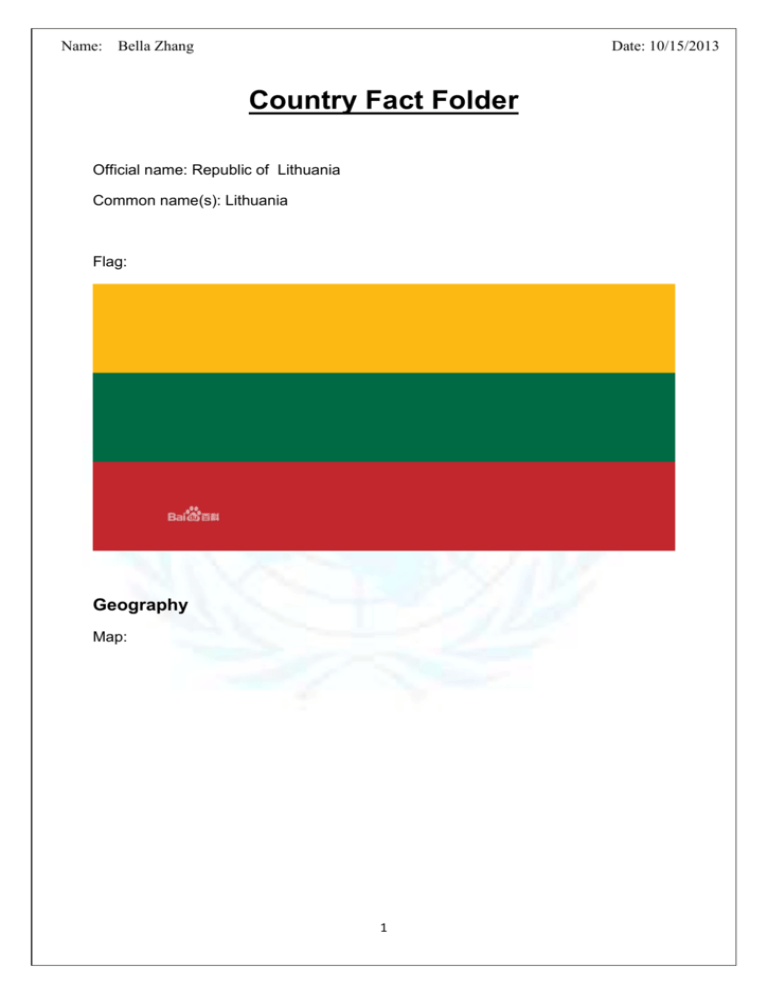
Name: Bella Zhang Date: 10/15/2013 Country Fact Folder Official name: Republic of Lithuania Common name(s): Lithuania Flag: Geography Map: 1 Location: a) Which continent is your country in? European Continent b) List all the countries that border your country: Latvia and Russia. c) Is any part of your country along the coast? If so, list all oceans/seas it touches: Bordering the Baltic Sea. Area: a) Total: 65,300 square km 2 b) Land: 62,680 square km c) Water: 2,620 square km Natural resources, including well-known rivers, mountains, deserts, etc: (i.e. Gobi Desert, Nile River) peat, arable land, amber People Population: a) Total: 3,515,858 b) Male: c) Female: Population growth rate (how quickly the population grows): -0.28% Birth rate (the number of babies born for each 1,000 people): 9.36 births/1,00 0 populat ion Life expectancy (for how many years is the average person able to live): 75.77 years What are the biggest ethnic groups? (i.e. Turks, Han Chinese) Lithuanian What are the most common religions? (i.e. Christianity, Judaism, Buddhism) Roman Catholic Most common language(s) spoken: (i.e. Bahasa Malay, Norwegian) Lithuanian 3 How to say “hello” in most common language(s): Sveiki Literacy (the % of people who can read and write): a) Total: 99.7% b) Male: 99.7% c) Female: 99.7% How many years of school are children required to attend (i.e. 9, 12). 16 years Government Independence (what year was the country established as a modern nation-state?): 11 March 1990 (declared); 6 September 1991 (recognized by the Soviet Union); notable earlier dates: 6 July 125 3 (coronat ion of MINDAUGAS, tradit ional f ounding date), 1 July 1569 (Polish -Lithuanian Commonwealth created) Government type: parliamentar y democracy (i.e. representative democracy, constitutional monarchy) Capital: Vilnius Major cities: Vilnius Key political leaders: (i.e. President: Barack Obama) Gediminas VAGNO RIUS Participation in regional organizations, conventions, treaties, and agreements: (i.e. NATO, ASEAN, NAFTA) Australia Group, BA, BIS, CBSS, CD, CE, EAPC, EBRD, EIB, EU, FAO, IAEA, IBRD, ICAO, ICC (national comm ittees), ICRM, IDA, IFC, IFRCS, ILO, IMF, I MO, Interpol, IOC, IOM, IPU, ISO, ITU, ITUC (NGOs), MIGA, NATO, NIB, 4 NSG, OAS (obser ver ), OIF (observer), OPCW, OSCE, PCA, Schengen Convention, Participation in international organizations, conventions, treaties, and agreements: (i.e. Kyoko Protocol, United Nations, Genocide Convention) UN, UNCTAD, UNESCO, UNIDO, UNW TO, UPU, W CO, W HO, W IPO, W MO, W TO Describe the country’s position and influence in its region: (i.e. for China, you can say that it is an economic and political leader in Asia) Lithuania has a strong and stable economy among the country in east Europe. Describe the country’s position and influence internationally: (i.e. you can say that India is one of the rising economies in the world but is not at a point where it can be called a world leader in terms of economic, military, or political influence ) The economy of Lithuania grow rapidly so that it attracts a large number of foreign company to make investment in our country. Economy GDP: $66.08 billion as of year GDP per capita: $22,000 as of year Agricultural products: ·grain, potatoes, sugar beets, f lax, vegetables; beef , milk, eggs; f ish 5 Industries: metal-cutting machine tools, electric mot ors, television sets, ref rigerators and f reezers, petroleum ref ining, shipbuilding (small ships), f urniture making, text iles, f ood processing, f ertilizer s, agricultural machiner y, optical equipment, electronic components, computers, amber jewelr y What does the country import and export? Import: mineral pr oducts, machiner y and equipment, transport equipment, chemicals, text iles and clothing, metals Export: mineral products, machiner y and equipment, chem icals, text iles , f oodstuff s, plastics Which countries are your country’s biggest trade (import and export) partners? Russia Currency: (i.e. USD, RMB) Exchange rate (what is USD 1 equal to in your local money/currency?): (i.e. RMB 6.1 = USD 1) LTL 2.686=USD1 Military Military branches (the different parts of the military): (i.e. Turkish Armed Forces, Turkish Land Forces) Lithuanian Armed Forces : Land Forces, Naval Forces, Air Forces Manpower available for military service: a) Total: 1765,854 b) Males: 890,074 c) Females: 875,780 6 Military expenditures (% of GDP): 0.9% of GDP International Issues Military, political, and border issues: (i.e. my country is fighting with Y country over who the Z river belongs to OR my country is trying to join the European Union) a) Historical (past 500 years or longer): Lithuania has some argument of boundary with Russia. b) Recent (within past 10 years): There were some issues about drug. Economic issues: (A country wants to sell oil to B country with no tax, but B country will not agree) a) Historical (past 500 years or longer): Economy depression b) Recent (within past 10 years): The government didn’t offer enough work position for citizens. Environmental issues: (i.e. pollution, melting glaciers) a) Historical (past 500 years or longer): No. b) Recent (within past 10 years): No. Illicit trade (drugs, weapons, people, etc): 7 (i.e. heroine, machine guns) a) Historical (past 500 years or longer): b) Recent (within past 10 years): There are some issues about the drug trade in this country. Yes. The trade of heroine and other drug influence the security. Refugees and displaced persons: (i.e. 2,000+ people with no citizenship) a) Historical (past 500 years or longer): No. b) Recent (within past 10 years): No. Other disputes and issues (i.e. what is the news reporting about my country?): a) Historical (past 500 years or longer): No. b) Recent (within past 10 years): No. 8 What Do “Facts” Tell You About Your Country? 1. Is your country rich? How do you know? What “facts” tell you this? Yes. According to the GDP and GDP per capital 2. Is your country a developed, developing, or underdeveloped? How do you know? What “facts” tell you this? Developing. In this period of time Lithuania focus on industry development. 3. Is your country’s government stable (i.e. is it safe, are there wars, or are people likely to fight)? How do you know? What “facts” tell you this? Yes. Lithuania has a stable economy system. Our economy grows rapidly. There is few or nearly no conflicts or protest. 4. Does your country have lots of funds (money) it can use to help other countries? Or does your country usually get aid (help) from others? How do you know? What “facts” tell you this? Yes, Lithuania does. 9 5. Which countries are your allies (friends)? How do you know? What “facts” tell you this? China, Russia, Poland.. 6. Which countries are your enemies? How do you know? What “facts” tell you this? No. 7. Do you have a strong military or do you depend on other countries to protect you? Which countries do you depend on? How do you know? What “facts” tell you this? Yes. Lithuania has a large population to serve for the military. 8. Do different ethnic groups and/or religions create any problems in your country? Which problems? How do you know? What “facts” tell you this? No. 10 9. Was your country ever a colony? It was a colony of which country/countries? How do you know? What “facts” tell you this? No. 10. Does your country depend on resources from other countries? Which resources? How do you know? What “facts” tell you this? Yes. Such like fabric. 11
